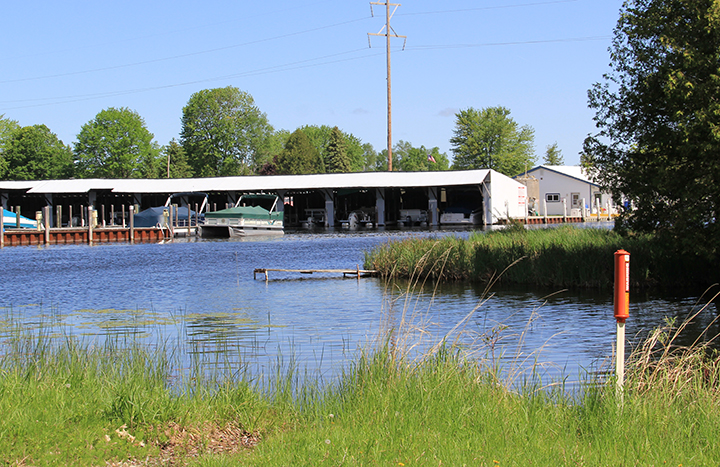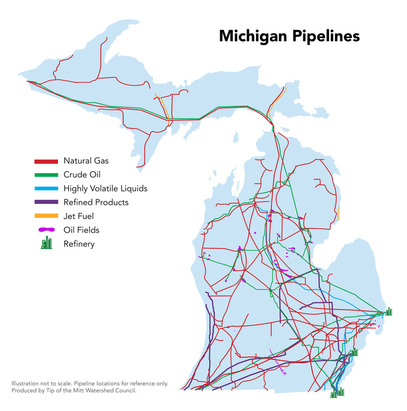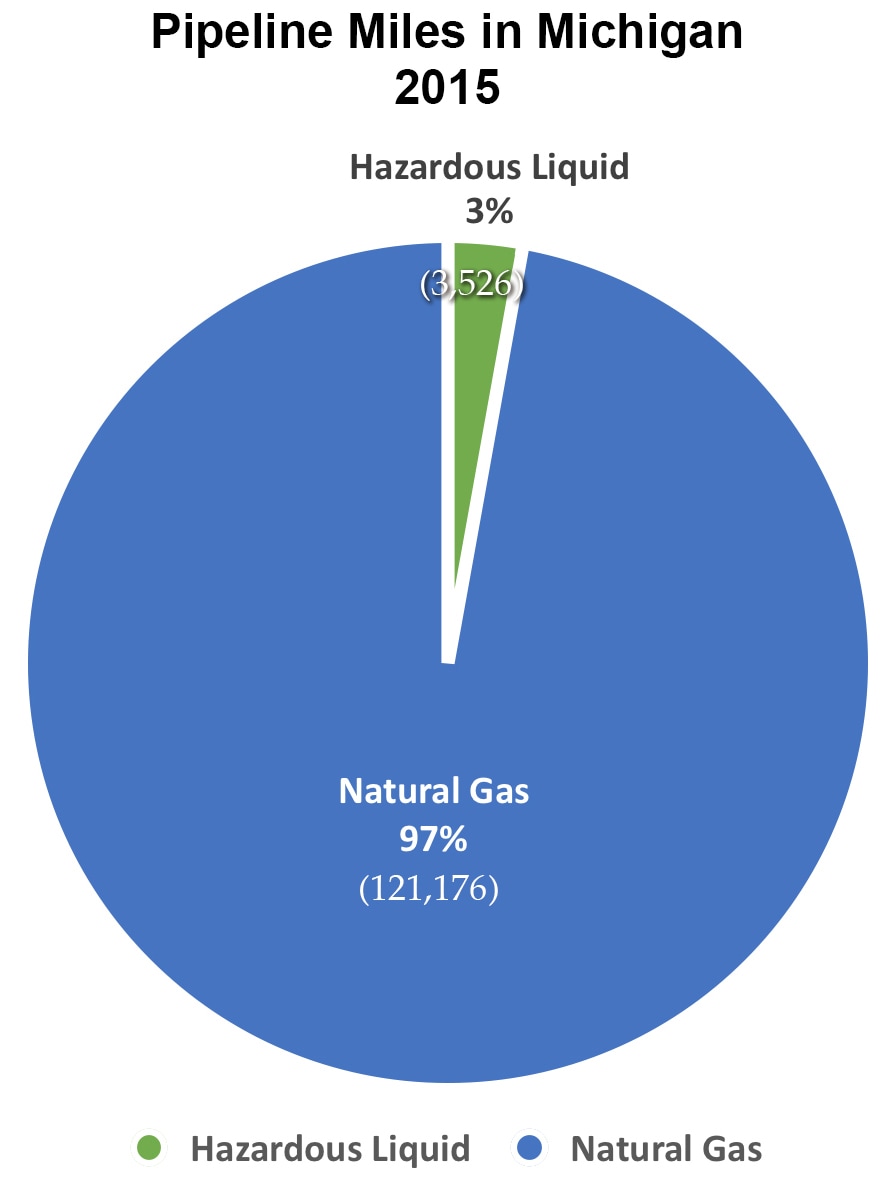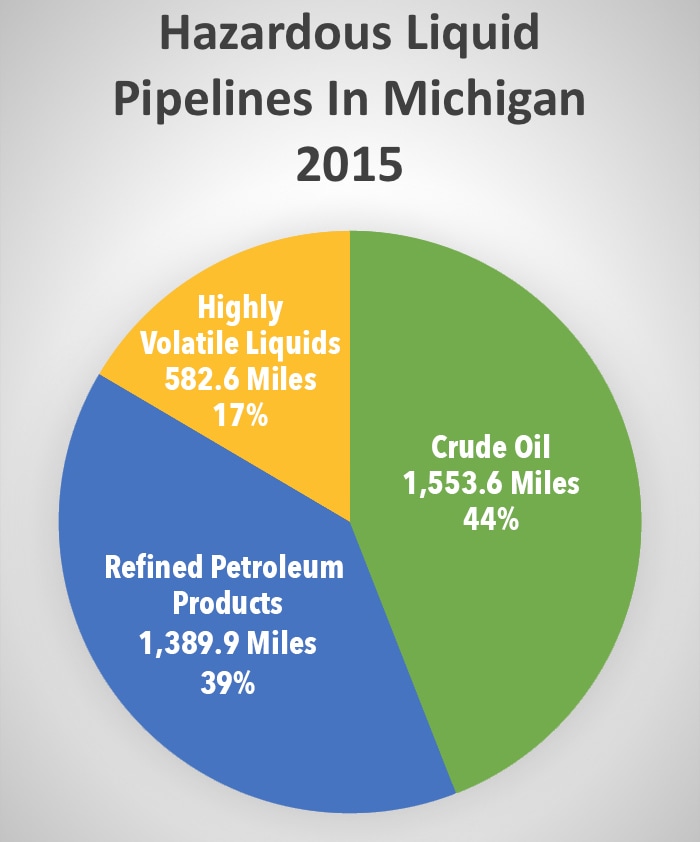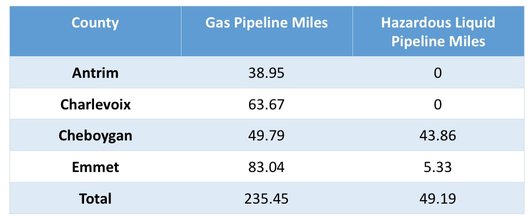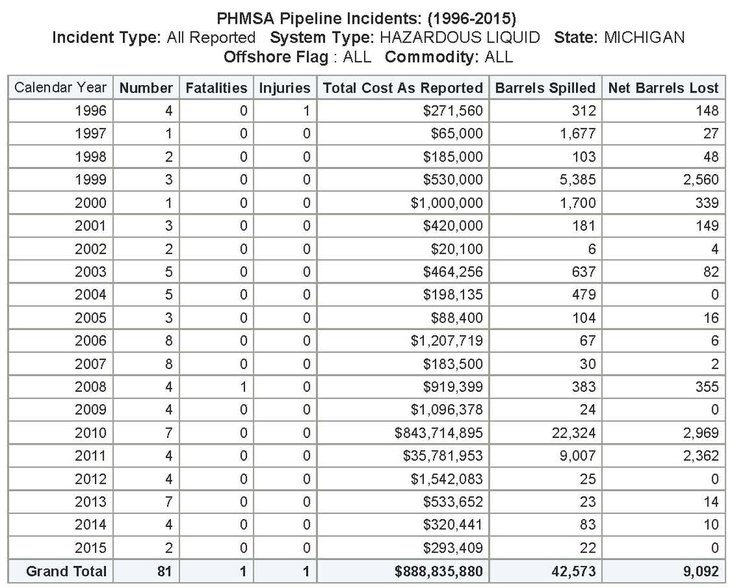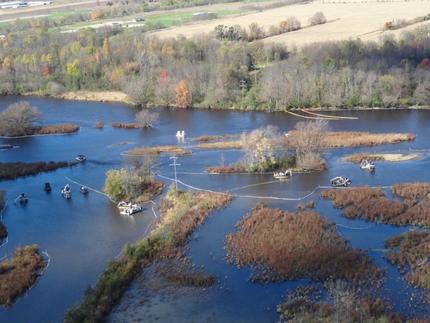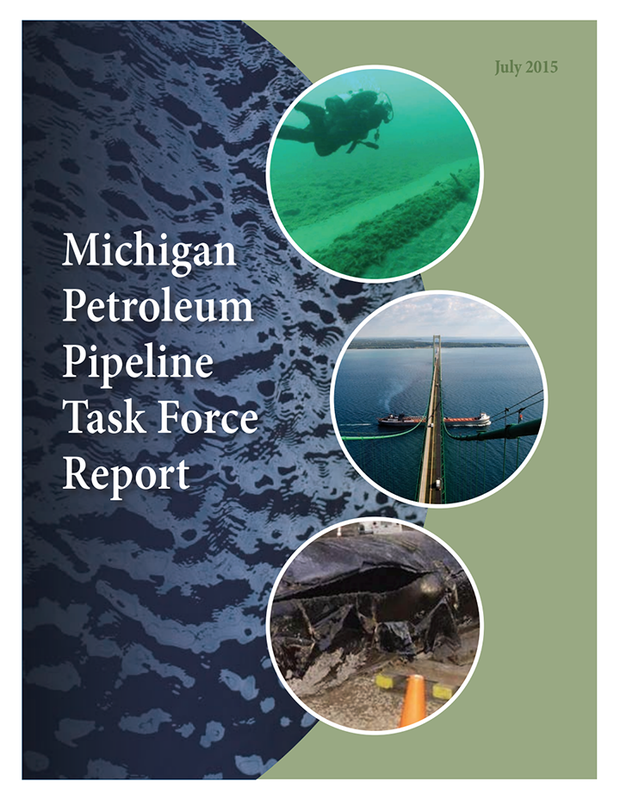The Great Lakes represent one-fifth of the world’s fresh surface water. Forty million people rely on the Great Lakes for their drinking water, and millions more benefit from the commerce and business that depend on the waters of the Great Lakes. At the same time, the Great Lakes region produces, refines, and transports substantial quantities of oil, natural gas, and other hazardous liquids. This makes the Great Lakes Basin particularly vulnerable to spills. In particular, pipelines crossing our rivers, streams, and Great Lakes put these resources at risk – threatening our health and economic viability.
Pipeline Mileage
As of 2013, Michigan was home to over 125,000 miles of fuel pipeline.
There are over 110,000 miles of pipelines that deliver natural gas to individual homes and businesses. Approximately 3% of the pipelines in Michigan transport hazardous liquids. This includes almost 600 miles of pipeline for highly volatile liquids (HVLs) (ethane, propane, ethylene, natural gas liquids), approximately 1,300 miles for refined petroleum products (gasoline, diesel fuel, jet fuel, condensate, etc.), and about over 1,500 miles of crude oil pipeline.
The majority of pipeline infrastructure in Michigan is located in the Detroit Metro area in Wayne and Oakland Counties. There is only a small percentage of pipelines in Northern Michigan. In Tip Mitt Watershed Council’s service area – the watersheds encompassing Antrim, Charlevoix, Cheboygan, and Emmet Counties – 285 miles of natural gas and hazardous liquid pipelines are buried beneath our feet. Of those 285 miles of pipeline, we have only one “hazardous liquid” pipeline, which is a pipeline that transports crude oil and natural gas liquids. This specific pipeline travels across 58.1 miles of our service area, including the Straits of Mackinac. All of the other pipelines transport natural gas to our homes and businesses. The one hazardous liquid pipeline is Line 5, owned and operated by Enbridge Energy, Limited Partnership.
Pipeline Incidents
Pipelines are considered to be the safest way to transport energy products. However, pipeline incidents, while rare, do still happen and the results can be catastrophic. The following table contains information from the Pipeline and Hazardous Materials Safety Administration (PHMSA) all on incidents occurring on hazardous liquids pipeline in Michigan from 1996-2015.
The 2010 numbers for property damage and gross barrels spilled are significantly higher than most years. This was a result of the pipeline rupture that occurred in Marshall, Michigan in July of 2010. An estimated 843,000 gallons of crude oil spilled, contaminating 38 miles of the Kalamazoo River with environmental impacts to water, sediment, and the shorelines of Kalamazoo River and Talmadge Creek. At EPA’s direction, Enbridge, the company who owned the pipeline, provided regular, updated estimates of how much oil it has recovered since the spill. These estimates are based on methods worked out with EPA technical experts to determine the amount of oil in all waste recovery categories: oil, contaminated water, soil, vegetation, debris, and cleanup materials. As of May 2013, Enbridge estimated the company has recovered 1.15 million gallons of oil from the Kalamazoo River, with cleanup costs over $1.2 billion.
Great Lakes Petroleum Task Force
As a response to the oil spill in Marshall and growing public concern about pipeline safety in Michigan, the State convened a multi-agency government task force to review pipeline safety in Michigan. The Task Force was co-chaired by the former Michigan Department of Environmental Quality Director Dan Wyant and Michigan Attorney General Bill Schuette. Other members of the Task Force included representatives from the Michigan Public Service Commission, Department of Natural Resources, Michigan Department of Environment, Great Lakes, and Energy (EGLE), Michigan Department of Transportation, and Michigan State Police, Emergency Management and Homeland Security Division.
The Task Force was focused initially on Enbridge’s Line 5 pipeline under the Mackinac Straits. The Task Force also addressed the state’s emergency management preparedness for spills, coordination of permitting issues for pipeline upgrades and replacement, and the creation of a state website to serve as an information clearinghouse for residents who have questions or concerns about pipelines.
The following formal presentations were made to the Task Force:
For the Michigan Petroleum Pipeline Task Force Report website, click here.
Four of the recommendations were specific to Line 5 in the Straits of Mackinac and nine pertained to the all pipelines in the State of Michigan. Specific Recommendations regarding the Straits Pipelines Statewide Recommendations |
Tip of the Mitt Watershed Council believes these the pipeline safety recommendations will go a long way toward safeguarding the Great Lakes and Michigan’s inland waters from oil spills, but only if they are implemented with a sense of urgency and accountability. In implementing these recommendations, it’s important that state leaders set a clear and aggressive timeline, establish strong enforcement mechanisms to ensure Enbridge follows through with the required actions, and include the public in a transparent process.
On September 3, 2015, the State moved forward on two of the recommendations made in the Task Force Report.
First, the Governor issued an Executive Order creating the Pipeline Safety Advisory Board. The Advisory Board’s charge is to:
- Work towards the implementation of the recommendations made in the Task Force Report
- Identify BMPs for pipeline safety and siting
- Recommend measures to improve emergency response and planning
- Recommend ways to increase transparency and public engagement
Second, the State of Michigan and Enbridge entered into an agreement regarding the transportation of heavy crude through the pipelines in the Straits of Mackinac. Heavy crude, in general, is heavier than water and will sink if released into freshwater. While Enbridge has never transported heavy crude through Line 5, there was concern that future demand for heavy crude by refineries served by Enbridge could result in heavy crude being transported via Line 5.
Unfortunately, the agreement is weak, containing loopholes that could allow heavy crude to be transported through Line 5 in the future under certain circumstances. Under the agreement, Enbridge could transport heavy oil through the pipelines in the Straits if 1) the state approves changes to the engineering or operation of the pipelines that allows for transportation of heavy crude oil or 2) if Enbridge is ordered to transport heavy crude by a regulating agency.

